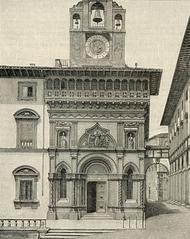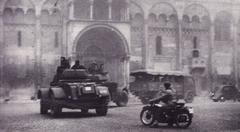Archaeological Area of the Sub-Sacristy of San Francesco Arezzo: Visiting Hours, Tickets, and Historical Significance
Date: 14/06/2025
Introduction
In the heart of Tuscany, the Archaeological Area of the Sub-Sacristy of San Francesco in Arezzo offers visitors a rare journey through the city’s layered history. Situated beneath the renowned Basilica di San Francesco, this extraordinary site brings to light archaeological treasures from ancient Etruscan and Roman times through medieval Franciscan developments and Renaissance artistry. Here, you can explore medieval masonry, sacred burials, and rare fresco fragments by artists like Spinello Aretino, as well as preparatory works for Piero della Francesca’s celebrated “Legend of the True Cross” fresco cycle.
The basilica itself, begun circa 1290, exemplifies Franciscan ideals of humility and simplicity in its architecture and unfinished façade. The sub-sacristy, located below the main church, serves as both an archaeological repository and a spiritual space, connecting visitors with centuries of sacred use and changing cultural identities in Arezzo.
This guide provides all essential information for planning your visit—including up-to-date opening hours, ticketing details, accessibility, and tips for guided tours. It also contextualizes the sub-sacristy within Arezzo’s broader cultural landscape, encouraging deeper exploration of the city’s historical gems such as the National Archaeological Museum Gaius Cilnius Maecenas and Piazza Grande. Whether you are an art lover, history enthusiast, or cultural traveler, the Sub-Sacristy of San Francesco promises an immersive experience into Arezzo’s living heritage (ilbelcasentino.it; audiala.com; borghiditoscana.net; visittuscany.com).
Table of Contents
- Introduction
- Historical Development
- Archaeological Discoveries
- Practical Visitor Information
- Notable Archaeological Finds
- Integration with Arezzo’s Heritage
- Frequently Asked Questions (FAQ)
- Conclusion and Visitor Tips
- References and Further Reading
Historical Development
Franciscan Arrival and Basilica Construction
The growth of the Franciscan order in Tuscany during the late 13th century led to the establishment of the Basilica of San Francesco in Arezzo. Construction began around 1290, replacing an earlier church that had been destroyed outside the city walls (ilbelcasentino.it; Wikipedia). The basilica’s architecture exemplifies Franciscan ideals with its single wide nave and groin-vaulted chancel. The unfinished sandstone and brick façade, rebuilt in 1346, continues to intrigue visitors with its visible drafts for decorative work (borghiditoscana.net).
The Sub-Sacristy: Structure and Purpose
Beneath the basilica lies the sub-sacristy and the so-called “Lower Church,” originally used by friars and now serving as an exhibition area. These spaces provide access to archaeological layers and remnants from earlier periods, preserving traces of the medieval and Renaissance development of the site (Wikipedia).
Archaeological Discoveries
Medieval and Renaissance Layers
Excavations in the sub-sacristy have revealed stratified layers that document the basilica’s construction and evolution:
- Foundations and Masonry: Original 13th- and 14th-century walls and supports illustrate the church’s changing footprint.
- Burials and Liturgical Features: Excavated medieval tombs and liturgical furnishings, such as altar bases and reliquary niches, provide insight into historical religious practices (ilbelcasentino.it).
Artistic Heritage and Frescoes
The basilica’s interior was once adorned with extensive frescoes:
- Spinello Aretino and Other Masters: Fragments of frescoes by Spinello Aretino and contemporaries are preserved in the lower church and sub-sacristy, reflecting the evolution of Tuscan mural painting (ilbelcasentino.it).
- Piero della Francesca’s “Legend of the True Cross”: The celebrated cycle in the Bacci Chapel was executed between 1452 and 1466. Preparatory drawings and related fragments in the sub-sacristy provide context for this masterpiece (borghiditoscana.net).
Arezzo’s Ancient Roots
Although the sub-sacristy focuses on medieval and Renaissance layers, Arezzo’s broader archaeological context includes significant Etruscan and Roman remains:
- Artifacts: The nearby National Archaeological Museum Gaius Cilnius Maecenas exhibits Etruscan and Roman jewelry, ceramics, and architectural fragments (nomads-travel-guide.com; summerinitaly.com).
- Urban Stratigraphy: The sub-sacristy exemplifies Arezzo’s continuous urban development from antiquity through the Renaissance.
Practical Visitor Information
Visiting Hours and Tickets
- Opening Hours: The Basilica di San Francesco typically opens from 9:00 AM to 7:00 PM, with last entry 30 minutes before closing. Seasonal and holiday variations may apply.
- Sub-Sacristy Access: The sub-sacristy is generally accessible only by guided tour, which should be booked in advance due to limited capacity and preservation needs. Check the official Basilica website for updated schedules.
- Tickets: Tickets can be bought online (pierodellafrancesca-ticketoffice.it) or at the site. Combined passes may include the basilica, sub-sacristy, and Bacci Chapel.
- Prices: Standard tickets range from €5–€10, with discounts for students, seniors, and groups. Children under a certain age may enter free.
Accessibility
The basilica provides ramps and accessible areas, but the sub-sacristy involves stairs and uneven surfaces, which may restrict access for visitors with mobility challenges. Contact the site in advance for specific needs.
Guided Tours
Guided tours are strongly recommended and focus on the art, history, and archaeology of the basilica complex. Special exhibitions and cultural events may take place in the lower church and sub-sacristy. Local agencies like Cortona Tourist Guide offer tailored tours that include the sub-sacristy as part of broader Arezzo historical sites visits.
Nearby Attractions
Arezzo is rich in historical sites worth exploring:
- National Archaeological Museum Gaius Cilnius Maecenas: Extensive Etruscan and Roman collections.
- Piazza Grande: The city’s main square, renowned for medieval architecture.
- Museums and Churches: Including the House of Giorgio Vasari and other Renaissance landmarks.
Notable Archaeological Finds
- Fresco Fragments: 14th–15th century fresco remains, including sinopie, attributed to notable artists and revealing painting techniques (ilbelcasentino.it).
- Architectural Elements: Medieval masonry, altar bases, and reliquary niches that connect visitors to the basilica’s origins.
- Funerary Discoveries: Medieval burials offering insight into Franciscan and local burial customs.
Integration with Arezzo’s Heritage
The sub-sacristy is a key point in Arezzo’s archaeological network, which includes Etruscan necropoleis and Roman amphitheaters. Combining your visit with the National Archaeological Museum provides a comprehensive overview of Arezzo’s ancient and medieval development (nomads-travel-guide.com).
Frequently Asked Questions (FAQ)
Q: What are the visiting hours for the Basilica and Sub-Sacristy?
A: The basilica is generally open from 9:00 AM to 7:00 PM. Access to the Sub-Sacristy is by guided tour with specific times; check the official website.
Q: How can I buy tickets?
A: Purchase online at pierodellafrancesca-ticketoffice.it or at the ticket office.
Q: Are the sites accessible for visitors with disabilities?
A: The basilica is partially accessible; the sub-sacristy may be challenging due to stairs and uneven terrain.
Q: Are guided tours available?
A: Yes, guided tours are offered and highly recommended.
Q: What else should I see in Arezzo?
A: Don’t miss the National Archaeological Museum, Piazza Grande, and the House of Giorgio Vasari.
Conclusion and Visitor Tips
Visiting the Sub-Sacristy of San Francesco in Arezzo is a journey through centuries of spiritual devotion, artistic innovation, and archaeological discovery. The site’s layers—from Etruscan foundations to Renaissance frescoes—offer a tangible link to Arezzo’s remarkable history. For the best experience:
- Book tickets and tours in advance.
- Wear comfortable shoes for uneven surfaces.
- Respect preservation rules and the sacred nature of the site.
- Combine your visit with other major attractions in Arezzo.
- Download the Audiala app for audio guides and detailed insights.
By following these tips, you’ll enrich your understanding of one of Tuscany’s most authentic and culturally significant destinations.
References and Further Reading
- Il Bel Casentino – Basilica di San Francesco
- Audiala – Sub-Sacristy of San Francesco Arezzo
- Wikipedia – Basilica of San Francesco, Arezzo
- Borghi di Toscana – Bacci Chapel Frescoes
- Visit Tuscany – San Francesco Basilica
- Cortona Tourist Guide – Arezzo Archaeological Tour
- Be La Vie – How to Spend a Day in Arezzo
- Nomads Travel Guide – National Archaeological Museum Gaius Cilnius Maecenas
- I Travel for the Stars – Arezzo Travel Guide
- ItaloAmericano – Arezzo Historical and Cultural Insights
- Love from Tuscany – Arezzo City Guide





